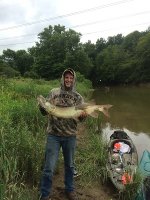It most likely is the Ohio lamprey, and while rare overall, is reasonably common throughout the Ohio drainage, and parasitic, though much smaller than the sea lampreys found in the Delaware and great lakes drainages. I see large numbers of them in the NW portion of the state. Oil Creek is a good example that seems to have a lot. At certain times of the year, you can see them in numbers lying belly up on the streambed, not sure if they are dead (after breeding), exhibiting mating behavior, or waiting for a host to swim over? Occasionally you catch trout with them attached as well. I've caught fish in the Kiski with them attached (I grew up in Leechburg, PA), so them being in the Loyalhanna makes sense.
Northern Brook Lamprey, in PA, is only found in the Great Lakes system.
American Brook Lamprey, in PA, is only in the upper reaches of the Allegheny watershed plus great lakes and Genesee watersheds.
Mountain Brook Lamprey is a possibility as they are in the Ohio drainage, but significantly more rare. It is nonparasitic.
Least Brook Lamprey is another possibility, but also rare and typically only in extreme headwaters.
Ohio lamprey makes the most sense.





